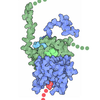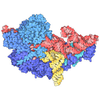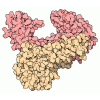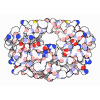[English] 日本語
 Yorodumi
Yorodumi- PDB-5ijn: Composite structure of the inner ring of the human nuclear pore c... -
+ Open data
Open data
- Basic information
Basic information
| Entry | Database: PDB / ID: 5ijn | ||||||
|---|---|---|---|---|---|---|---|
| Title | Composite structure of the inner ring of the human nuclear pore complex (32 copies of Nup205) | ||||||
 Components Components |
| ||||||
 Keywords Keywords | TRANSPORT PROTEIN / Nuclear pore complex / Nucleocytoplasmic transport | ||||||
| Function / homology |  Function and homology information Function and homology informationcentriole assembly / positive regulation of centriole replication / regulation of protein import into nucleus / regulation of Ras protein signal transduction / positive regulation of mitotic cytokinetic process / protein localization to nuclear inner membrane / nuclear envelope organization / nuclear pore inner ring / nuclear pore central transport channel / transcription-dependent tethering of RNA polymerase II gene DNA at nuclear periphery ...centriole assembly / positive regulation of centriole replication / regulation of protein import into nucleus / regulation of Ras protein signal transduction / positive regulation of mitotic cytokinetic process / protein localization to nuclear inner membrane / nuclear envelope organization / nuclear pore inner ring / nuclear pore central transport channel / transcription-dependent tethering of RNA polymerase II gene DNA at nuclear periphery / nuclear pore complex assembly / nuclear pore organization / atrial cardiac muscle cell action potential / positive regulation of protein localization to centrosome / Nuclear Pore Complex (NPC) Disassembly / Regulation of Glucokinase by Glucokinase Regulatory Protein / Defective TPR may confer susceptibility towards thyroid papillary carcinoma (TPC) / Transport of Ribonucleoproteins into the Host Nucleus / miRNA processing / Transport of the SLBP independent Mature mRNA / Transport of the SLBP Dependant Mature mRNA / NS1 Mediated Effects on Host Pathways / negative regulation of Ras protein signal transduction / NLS-bearing protein import into nucleus / SUMOylation of SUMOylation proteins / nuclear localization sequence binding / structural constituent of nuclear pore / Transport of Mature mRNA Derived from an Intronless Transcript / Rev-mediated nuclear export of HIV RNA / Nuclear import of Rev protein / Flemming body / SUMOylation of RNA binding proteins / mitotic centrosome separation / NEP/NS2 Interacts with the Cellular Export Machinery / RNA export from nucleus / Transport of Mature mRNA derived from an Intron-Containing Transcript / tRNA processing in the nucleus / Postmitotic nuclear pore complex (NPC) reformation / centrosome cycle / negative regulation of programmed cell death / nucleocytoplasmic transport / positive regulation of epidermal growth factor receptor signaling pathway / Viral Messenger RNA Synthesis / PTB domain binding / poly(A)+ mRNA export from nucleus / mitotic metaphase chromosome alignment / SUMOylation of ubiquitinylation proteins / Vpr-mediated nuclear import of PICs / negative regulation of epidermal growth factor receptor signaling pathway / SUMOylation of DNA replication proteins / positive regulation of SMAD protein signal transduction / Regulation of HSF1-mediated heat shock response / regulation of signal transduction / mRNA transport / nuclear pore / mRNA export from nucleus / SUMOylation of DNA damage response and repair proteins / Hsp70 protein binding / positive regulation of mitotic nuclear division / SH2 domain binding / nuclear periphery / regulation of mitotic spindle organization / SUMOylation of chromatin organization proteins / ubiquitin binding / HCMV Late Events / Hsp90 protein binding / Transcriptional regulation by small RNAs / phospholipid binding / ISG15 antiviral mechanism / protein import into nucleus / HCMV Early Events / spindle pole / mitotic spindle / cellular senescence / nuclear envelope / protein transport / signaling receptor complex adaptor activity / snRNP Assembly / nuclear membrane / cell surface receptor signaling pathway / positive regulation of canonical NF-kappaB signal transduction / ribonucleoprotein complex / negative regulation of cell population proliferation / centrosome / chromatin binding / negative regulation of apoptotic process / positive regulation of DNA-templated transcription / protein-containing complex binding / SARS-CoV-2 activates/modulates innate and adaptive immune responses / nucleoplasm / identical protein binding / membrane / cytoplasm / cytosol Similarity search - Function | ||||||
| Biological species |  Homo sapiens (human) Homo sapiens (human) | ||||||
| Method | ELECTRON MICROSCOPY / subtomogram averaging / cryo EM / Resolution: 21.4 Å | ||||||
 Authors Authors | Kosinski, J. / Mosalaganti, S. / von Appen, A. / Beck, M. | ||||||
| Funding support |  Germany, 1items Germany, 1items
| ||||||
 Citation Citation |  Journal: Science / Year: 2016 Journal: Science / Year: 2016Title: Molecular architecture of the inner ring scaffold of the human nuclear pore complex. Authors: Jan Kosinski / Shyamal Mosalaganti / Alexander von Appen / Roman Teimer / Amanda L DiGuilio / William Wan / Khanh Huy Bui / Wim J H Hagen / John A G Briggs / Joseph S Glavy / Ed Hurt / Martin Beck /    Abstract: Nuclear pore complexes (NPCs) are 110-megadalton assemblies that mediate nucleocytoplasmic transport. NPCs are built from multiple copies of ~30 different nucleoporins, and understanding how these ...Nuclear pore complexes (NPCs) are 110-megadalton assemblies that mediate nucleocytoplasmic transport. NPCs are built from multiple copies of ~30 different nucleoporins, and understanding how these nucleoporins assemble into the NPC scaffold imposes a formidable challenge. Recently, it has been shown how the Y complex, a prominent NPC module, forms the outer rings of the nuclear pore. However, the organization of the inner ring has remained unknown until now. We used molecular modeling combined with cross-linking mass spectrometry and cryo-electron tomography to obtain a composite structure of the inner ring. This architectural map explains the vast majority of the electron density of the scaffold. We conclude that despite obvious differences in morphology and composition, the higher-order structure of the inner and outer rings is unexpectedly similar. | ||||||
| History |
|
- Structure visualization
Structure visualization
| Movie |
 Movie viewer Movie viewer |
|---|---|
| Structure viewer | Molecule:  Molmil Molmil Jmol/JSmol Jmol/JSmol |
- Downloads & links
Downloads & links
- Download
Download
| PDBx/mmCIF format |  5ijn.cif.gz 5ijn.cif.gz | 15.5 MB | Display |  PDBx/mmCIF format PDBx/mmCIF format |
|---|---|---|---|---|
| PDB format |  pdb5ijn.ent.gz pdb5ijn.ent.gz | 10.4 MB | Display |  PDB format PDB format |
| PDBx/mmJSON format |  5ijn.json.gz 5ijn.json.gz | Tree view |  PDBx/mmJSON format PDBx/mmJSON format | |
| Others |  Other downloads Other downloads |
-Validation report
| Arichive directory |  https://data.pdbj.org/pub/pdb/validation_reports/ij/5ijn https://data.pdbj.org/pub/pdb/validation_reports/ij/5ijn ftp://data.pdbj.org/pub/pdb/validation_reports/ij/5ijn ftp://data.pdbj.org/pub/pdb/validation_reports/ij/5ijn | HTTPS FTP |
|---|
-Related structure data
- Links
Links
- Assembly
Assembly
| Deposited unit | 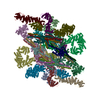
|
|---|---|
| 1 | x 8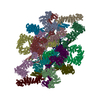
|
| Number of models | 8 |
| Symmetry | Point symmetry: (Schoenflies symbol: C8 (8 fold cyclic)) |
- Components
Components
-NUCLEAR PORE COMPLEX PROTEIN ... , 5 types, 22 molecules ABEKQWCIOUDJPVFLRXGMSY
| #1: Protein | Mass: 155357.281 Da / Num. of mol.: 6 Source method: isolated from a genetically manipulated source Source: (gene. exp.)  Homo sapiens (human) / Cell line: HELA / Cell line (production host): HELA / Production host: Homo sapiens (human) / Cell line: HELA / Cell line (production host): HELA / Production host:  Homo sapiens (human) / References: UniProt: O75694 Homo sapiens (human) / References: UniProt: O75694#2: Protein | Mass: 93599.102 Da / Num. of mol.: 4 Source method: isolated from a genetically manipulated source Source: (gene. exp.)  Homo sapiens (human) / Cell line: HELA / Cell line (production host): HELA / Production host: Homo sapiens (human) / Cell line: HELA / Cell line (production host): HELA / Production host:  Homo sapiens (human) / References: UniProt: Q8N1F7 Homo sapiens (human) / References: UniProt: Q8N1F7#3: Protein | Mass: 228172.875 Da / Num. of mol.: 4 Source method: isolated from a genetically manipulated source Source: (gene. exp.)  Homo sapiens (human) / Cell line: HELA / Cell line (production host): HELA / Production host: Homo sapiens (human) / Cell line: HELA / Cell line (production host): HELA / Production host:  Homo sapiens (human) / References: UniProt: Q92621 Homo sapiens (human) / References: UniProt: Q92621#4: Protein | Mass: 55491.156 Da / Num. of mol.: 4 Source method: isolated from a genetically manipulated source Source: (gene. exp.)  Homo sapiens (human) / Cell line: HELA / Cell line (production host): HELA / Production host: Homo sapiens (human) / Cell line: HELA / Cell line (production host): HELA / Production host:  Homo sapiens (human) / References: UniProt: Q7Z3B4 Homo sapiens (human) / References: UniProt: Q7Z3B4#5: Protein | Mass: 60941.480 Da / Num. of mol.: 4 Source method: isolated from a genetically manipulated source Source: (gene. exp.)  Homo sapiens (human) / Cell line: HELA / Cell line (production host): HELA / Production host: Homo sapiens (human) / Cell line: HELA / Cell line (production host): HELA / Production host:  Homo sapiens (human) / References: UniProt: Q9BVL2 Homo sapiens (human) / References: UniProt: Q9BVL2 |
|---|
-Protein , 1 types, 4 molecules HNTZ
| #6: Protein | Mass: 53289.574 Da / Num. of mol.: 4 Source method: isolated from a genetically manipulated source Source: (gene. exp.)  Homo sapiens (human) / Cell line: HELA / Gene: NUP62 / Cell line (production host): HELA / Production host: Homo sapiens (human) / Cell line: HELA / Gene: NUP62 / Cell line (production host): HELA / Production host:  Homo sapiens (human) / References: UniProt: P37198 Homo sapiens (human) / References: UniProt: P37198 |
|---|
-Experimental details
-Experiment
| Experiment | Method: ELECTRON MICROSCOPY |
|---|---|
| EM experiment | Aggregation state: PARTICLE / 3D reconstruction method: subtomogram averaging |
- Sample preparation
Sample preparation
| Component | Name: Nuclear envelope / Type: COMPLEX / Entity ID: #1-#7 / Source: MULTIPLE SOURCES |
|---|---|
| Molecular weight | Value: 23 MDa / Experimental value: NO |
| Buffer solution | pH: 7.5 |
| Specimen | Embedding applied: NO / Shadowing applied: NO / Staining applied: NO / Vitrification applied: YES |
| Vitrification | Cryogen name: ETHANE-PROPANE |
- Electron microscopy imaging
Electron microscopy imaging
| Experimental equipment |  Model: Titan Krios / Image courtesy: FEI Company |
|---|---|
| Microscopy | Model: FEI TITAN KRIOS |
| Electron gun | Electron source:  FIELD EMISSION GUN / Accelerating voltage: 300 kV / Illumination mode: OTHER FIELD EMISSION GUN / Accelerating voltage: 300 kV / Illumination mode: OTHER |
| Electron lens | Mode: BRIGHT FIELD |
| Image recording | Electron dose: 3 e/Å2 / Detector mode: SUPER-RESOLUTION / Film or detector model: GATAN K2 QUANTUM (4k x 4k) |
- Processing
Processing
| EM software |
| ||||||||||||||||
|---|---|---|---|---|---|---|---|---|---|---|---|---|---|---|---|---|---|
| EM 3D crystal entity | ∠α: 90 ° / ∠β: 90 ° / ∠γ: 90 ° / A: 1 Å / B: 1 Å / C: 1 Å / Space group name: P1 / Space group num: 1 | ||||||||||||||||
| CTF correction | Type: PHASE FLIPPING ONLY | ||||||||||||||||
| Symmetry | Point symmetry: C1 (asymmetric) | ||||||||||||||||
| 3D reconstruction | Resolution: 21.4 Å / Resolution method: FSC 0.143 CUT-OFF / Num. of particles: 8400 / Symmetry type: POINT | ||||||||||||||||
| EM volume selection | Num. of tomograms: 101 / Num. of volumes extracted: 1112 | ||||||||||||||||
| Atomic model building | Protocol: RIGID BODY FIT Details: this pdb structure includes unambiguous fits only, .i.e. excluding the middle domain of nup205. the structure with that domain can be obtained from authors. protein-protein interfaces shall ...Details: this pdb structure includes unambiguous fits only, .i.e. excluding the middle domain of nup205. the structure with that domain can be obtained from authors. protein-protein interfaces shall not be interpreted at residue-level resolution. this pdb structure contains eight models. the model 1 corresponds to the composite structure reported in the journal article associated with this entry. models 2-8 corresponds to the seven best scoring models automatically generated as described in the article. |
 Movie
Movie Controller
Controller





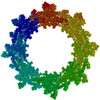

 PDBj
PDBj
